Strategic Planning and Analysis Report: Mulberry Group Plc
VerifiedAdded on 2019/12/03
|19
|6316
|210
Report
AI Summary
This report provides a comprehensive analysis of Mulberry's business strategy, encompassing various aspects of strategic planning and implementation. It begins by examining how mission, vision, objectives, goals, and core competencies inform strategic planning within the company. The report delves into factors crucial for developing strategic plans, including both internal and external environmental considerations, such as economic conditions, competition, and technological advancements. Furthermore, it evaluates the effectiveness of techniques used in developing strategic business plans, such as the BCG model, PIMS, and SPACE matrix. The analysis extends to organizational and environmental audits, utilizing SWOT and PESTLE analyses to assess Mulberry's strengths, weaknesses, opportunities, and threats, as well as political, economic, social, technological, environmental, and legal factors. The report also explores the significance of stakeholder analysis in formulating new strategies for Mulberry. It then proposes and justifies a new strategy for Mulberry, outlining the roles and responsibilities of personnel involved in strategy implementation and estimating resource requirements. The contribution of SMART targets to the achievement of strategy implementation is also discussed, concluding with an overview of the key findings and recommendations for Mulberry's future strategic direction.
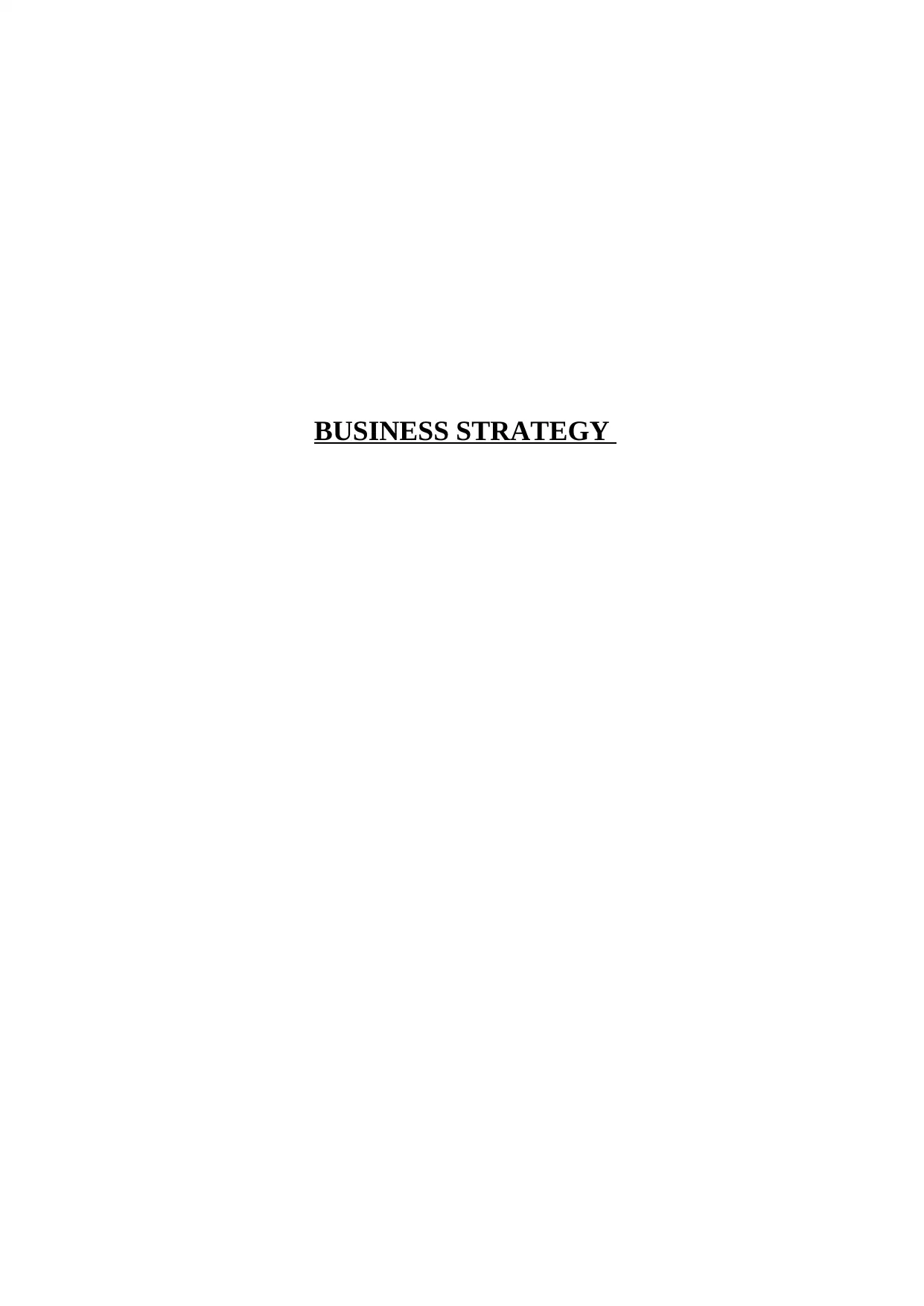
BUSINESS STRATEGY
Paraphrase This Document
Need a fresh take? Get an instant paraphrase of this document with our AI Paraphraser
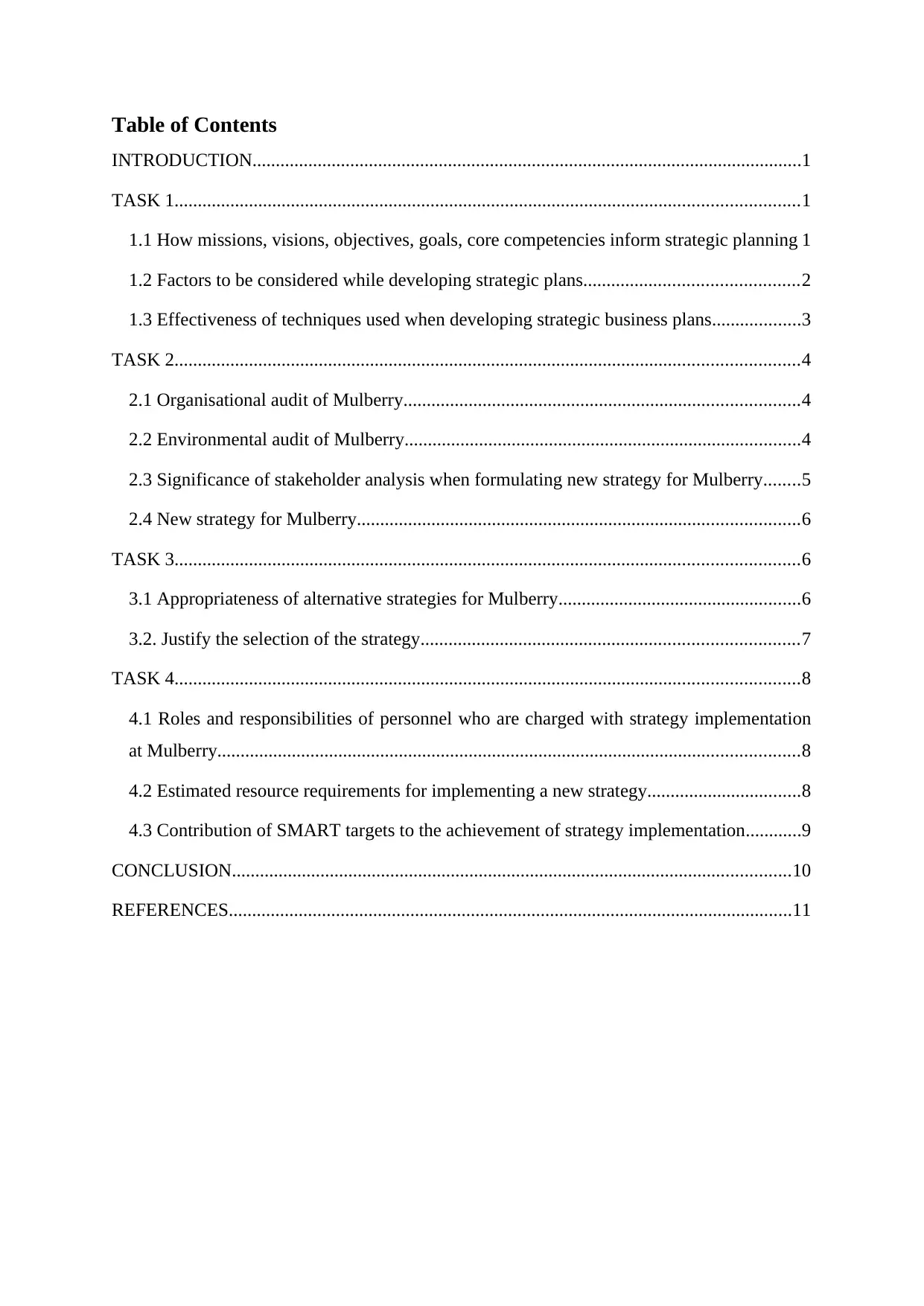
Table of Contents
INTRODUCTION......................................................................................................................1
TASK 1......................................................................................................................................1
1.1 How missions, visions, objectives, goals, core competencies inform strategic planning 1
1.2 Factors to be considered while developing strategic plans..............................................2
1.3 Effectiveness of techniques used when developing strategic business plans...................3
TASK 2......................................................................................................................................4
2.1 Organisational audit of Mulberry.....................................................................................4
2.2 Environmental audit of Mulberry.....................................................................................4
2.3 Significance of stakeholder analysis when formulating new strategy for Mulberry........5
2.4 New strategy for Mulberry...............................................................................................6
TASK 3......................................................................................................................................6
3.1 Appropriateness of alternative strategies for Mulberry....................................................6
3.2. Justify the selection of the strategy.................................................................................7
TASK 4......................................................................................................................................8
4.1 Roles and responsibilities of personnel who are charged with strategy implementation
at Mulberry.............................................................................................................................8
4.2 Estimated resource requirements for implementing a new strategy.................................8
4.3 Contribution of SMART targets to the achievement of strategy implementation............9
CONCLUSION........................................................................................................................10
REFERENCES.........................................................................................................................11
INTRODUCTION......................................................................................................................1
TASK 1......................................................................................................................................1
1.1 How missions, visions, objectives, goals, core competencies inform strategic planning 1
1.2 Factors to be considered while developing strategic plans..............................................2
1.3 Effectiveness of techniques used when developing strategic business plans...................3
TASK 2......................................................................................................................................4
2.1 Organisational audit of Mulberry.....................................................................................4
2.2 Environmental audit of Mulberry.....................................................................................4
2.3 Significance of stakeholder analysis when formulating new strategy for Mulberry........5
2.4 New strategy for Mulberry...............................................................................................6
TASK 3......................................................................................................................................6
3.1 Appropriateness of alternative strategies for Mulberry....................................................6
3.2. Justify the selection of the strategy.................................................................................7
TASK 4......................................................................................................................................8
4.1 Roles and responsibilities of personnel who are charged with strategy implementation
at Mulberry.............................................................................................................................8
4.2 Estimated resource requirements for implementing a new strategy.................................8
4.3 Contribution of SMART targets to the achievement of strategy implementation............9
CONCLUSION........................................................................................................................10
REFERENCES.........................................................................................................................11
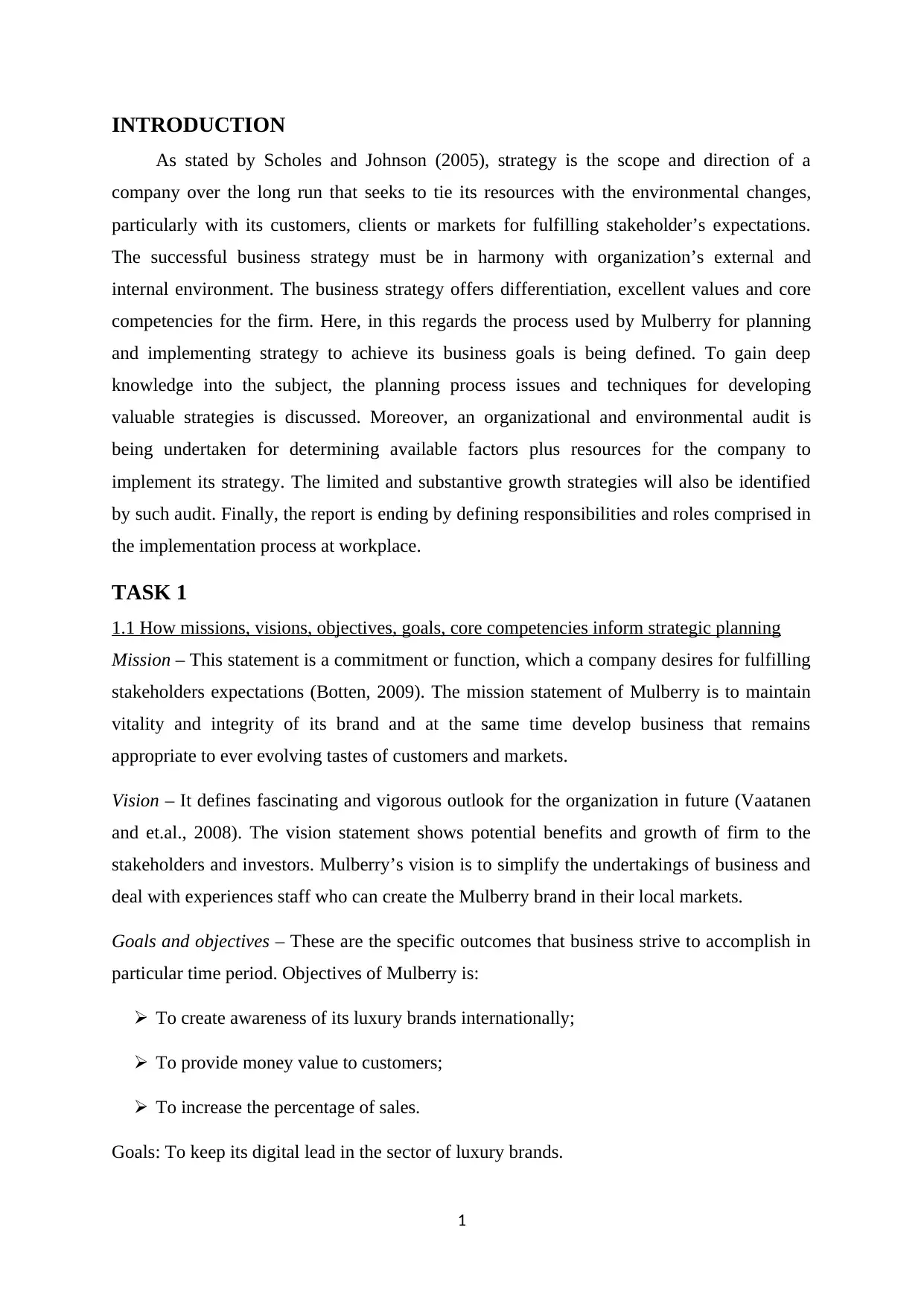
INTRODUCTION
As stated by Scholes and Johnson (2005), strategy is the scope and direction of a
company over the long run that seeks to tie its resources with the environmental changes,
particularly with its customers, clients or markets for fulfilling stakeholder’s expectations.
The successful business strategy must be in harmony with organization’s external and
internal environment. The business strategy offers differentiation, excellent values and core
competencies for the firm. Here, in this regards the process used by Mulberry for planning
and implementing strategy to achieve its business goals is being defined. To gain deep
knowledge into the subject, the planning process issues and techniques for developing
valuable strategies is discussed. Moreover, an organizational and environmental audit is
being undertaken for determining available factors plus resources for the company to
implement its strategy. The limited and substantive growth strategies will also be identified
by such audit. Finally, the report is ending by defining responsibilities and roles comprised in
the implementation process at workplace.
TASK 1
1.1 How missions, visions, objectives, goals, core competencies inform strategic planning
Mission – This statement is a commitment or function, which a company desires for fulfilling
stakeholders expectations (Botten, 2009). The mission statement of Mulberry is to maintain
vitality and integrity of its brand and at the same time develop business that remains
appropriate to ever evolving tastes of customers and markets.
Vision – It defines fascinating and vigorous outlook for the organization in future (Vaatanen
and et.al., 2008). The vision statement shows potential benefits and growth of firm to the
stakeholders and investors. Mulberry’s vision is to simplify the undertakings of business and
deal with experiences staff who can create the Mulberry brand in their local markets.
Goals and objectives – These are the specific outcomes that business strive to accomplish in
particular time period. Objectives of Mulberry is:
To create awareness of its luxury brands internationally;
To provide money value to customers;
To increase the percentage of sales.
Goals: To keep its digital lead in the sector of luxury brands.
1
As stated by Scholes and Johnson (2005), strategy is the scope and direction of a
company over the long run that seeks to tie its resources with the environmental changes,
particularly with its customers, clients or markets for fulfilling stakeholder’s expectations.
The successful business strategy must be in harmony with organization’s external and
internal environment. The business strategy offers differentiation, excellent values and core
competencies for the firm. Here, in this regards the process used by Mulberry for planning
and implementing strategy to achieve its business goals is being defined. To gain deep
knowledge into the subject, the planning process issues and techniques for developing
valuable strategies is discussed. Moreover, an organizational and environmental audit is
being undertaken for determining available factors plus resources for the company to
implement its strategy. The limited and substantive growth strategies will also be identified
by such audit. Finally, the report is ending by defining responsibilities and roles comprised in
the implementation process at workplace.
TASK 1
1.1 How missions, visions, objectives, goals, core competencies inform strategic planning
Mission – This statement is a commitment or function, which a company desires for fulfilling
stakeholders expectations (Botten, 2009). The mission statement of Mulberry is to maintain
vitality and integrity of its brand and at the same time develop business that remains
appropriate to ever evolving tastes of customers and markets.
Vision – It defines fascinating and vigorous outlook for the organization in future (Vaatanen
and et.al., 2008). The vision statement shows potential benefits and growth of firm to the
stakeholders and investors. Mulberry’s vision is to simplify the undertakings of business and
deal with experiences staff who can create the Mulberry brand in their local markets.
Goals and objectives – These are the specific outcomes that business strive to accomplish in
particular time period. Objectives of Mulberry is:
To create awareness of its luxury brands internationally;
To provide money value to customers;
To increase the percentage of sales.
Goals: To keep its digital lead in the sector of luxury brands.
1
⊘ This is a preview!⊘
Do you want full access?
Subscribe today to unlock all pages.

Trusted by 1+ million students worldwide
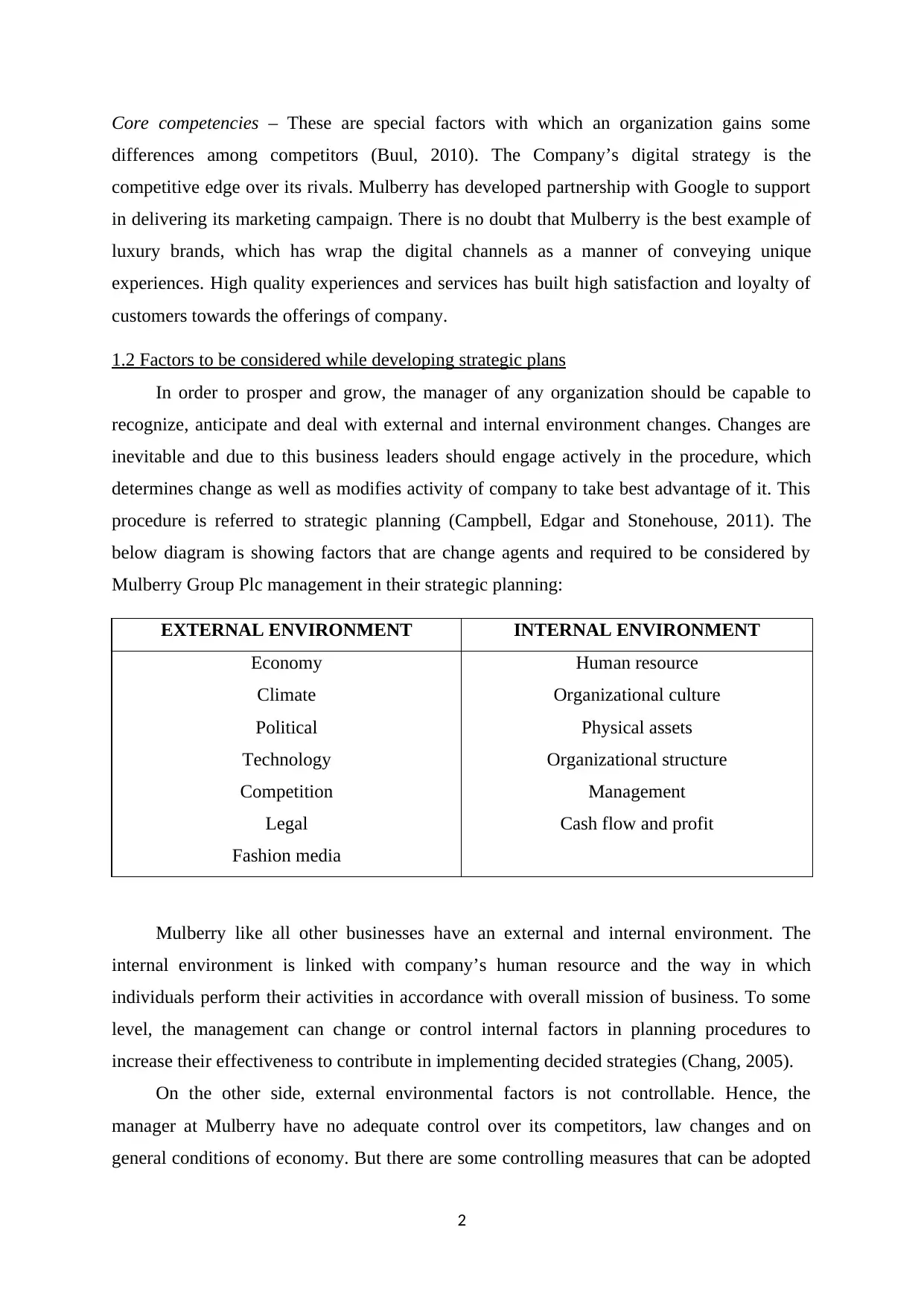
Core competencies – These are special factors with which an organization gains some
differences among competitors (Buul, 2010). The Company’s digital strategy is the
competitive edge over its rivals. Mulberry has developed partnership with Google to support
in delivering its marketing campaign. There is no doubt that Mulberry is the best example of
luxury brands, which has wrap the digital channels as a manner of conveying unique
experiences. High quality experiences and services has built high satisfaction and loyalty of
customers towards the offerings of company.
1.2 Factors to be considered while developing strategic plans
In order to prosper and grow, the manager of any organization should be capable to
recognize, anticipate and deal with external and internal environment changes. Changes are
inevitable and due to this business leaders should engage actively in the procedure, which
determines change as well as modifies activity of company to take best advantage of it. This
procedure is referred to strategic planning (Campbell, Edgar and Stonehouse, 2011). The
below diagram is showing factors that are change agents and required to be considered by
Mulberry Group Plc management in their strategic planning:
EXTERNAL ENVIRONMENT INTERNAL ENVIRONMENT
Economy
Climate
Political
Technology
Competition
Legal
Fashion media
Human resource
Organizational culture
Physical assets
Organizational structure
Management
Cash flow and profit
Mulberry like all other businesses have an external and internal environment. The
internal environment is linked with company’s human resource and the way in which
individuals perform their activities in accordance with overall mission of business. To some
level, the management can change or control internal factors in planning procedures to
increase their effectiveness to contribute in implementing decided strategies (Chang, 2005).
On the other side, external environmental factors is not controllable. Hence, the
manager at Mulberry have no adequate control over its competitors, law changes and on
general conditions of economy. But there are some controlling measures that can be adopted
2
differences among competitors (Buul, 2010). The Company’s digital strategy is the
competitive edge over its rivals. Mulberry has developed partnership with Google to support
in delivering its marketing campaign. There is no doubt that Mulberry is the best example of
luxury brands, which has wrap the digital channels as a manner of conveying unique
experiences. High quality experiences and services has built high satisfaction and loyalty of
customers towards the offerings of company.
1.2 Factors to be considered while developing strategic plans
In order to prosper and grow, the manager of any organization should be capable to
recognize, anticipate and deal with external and internal environment changes. Changes are
inevitable and due to this business leaders should engage actively in the procedure, which
determines change as well as modifies activity of company to take best advantage of it. This
procedure is referred to strategic planning (Campbell, Edgar and Stonehouse, 2011). The
below diagram is showing factors that are change agents and required to be considered by
Mulberry Group Plc management in their strategic planning:
EXTERNAL ENVIRONMENT INTERNAL ENVIRONMENT
Economy
Climate
Political
Technology
Competition
Legal
Fashion media
Human resource
Organizational culture
Physical assets
Organizational structure
Management
Cash flow and profit
Mulberry like all other businesses have an external and internal environment. The
internal environment is linked with company’s human resource and the way in which
individuals perform their activities in accordance with overall mission of business. To some
level, the management can change or control internal factors in planning procedures to
increase their effectiveness to contribute in implementing decided strategies (Chang, 2005).
On the other side, external environmental factors is not controllable. Hence, the
manager at Mulberry have no adequate control over its competitors, law changes and on
general conditions of economy. But there are some controlling measures that can be adopted
2
Paraphrase This Document
Need a fresh take? Get an instant paraphrase of this document with our AI Paraphraser
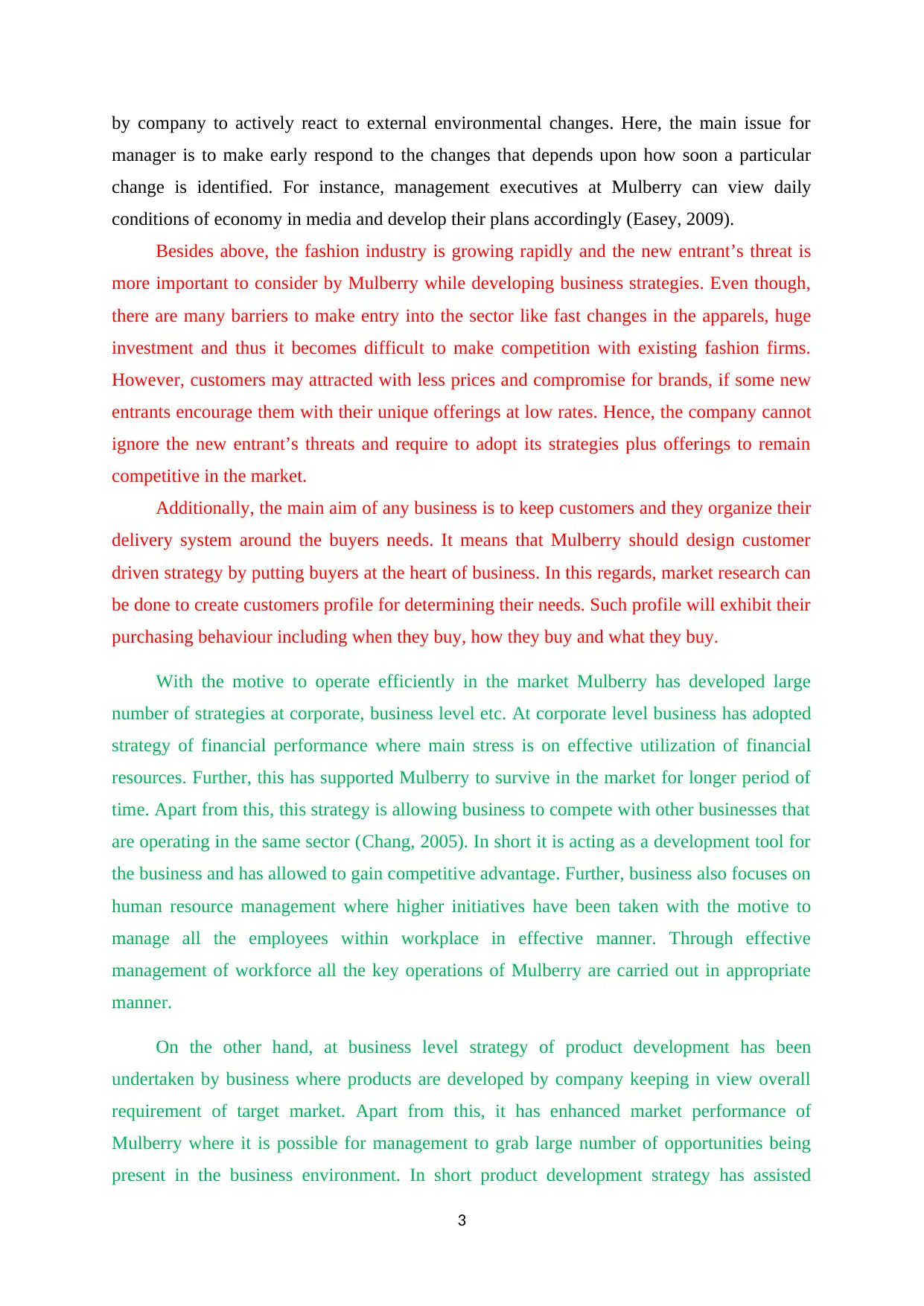
by company to actively react to external environmental changes. Here, the main issue for
manager is to make early respond to the changes that depends upon how soon a particular
change is identified. For instance, management executives at Mulberry can view daily
conditions of economy in media and develop their plans accordingly (Easey, 2009).
Besides above, the fashion industry is growing rapidly and the new entrant’s threat is
more important to consider by Mulberry while developing business strategies. Even though,
there are many barriers to make entry into the sector like fast changes in the apparels, huge
investment and thus it becomes difficult to make competition with existing fashion firms.
However, customers may attracted with less prices and compromise for brands, if some new
entrants encourage them with their unique offerings at low rates. Hence, the company cannot
ignore the new entrant’s threats and require to adopt its strategies plus offerings to remain
competitive in the market.
Additionally, the main aim of any business is to keep customers and they organize their
delivery system around the buyers needs. It means that Mulberry should design customer
driven strategy by putting buyers at the heart of business. In this regards, market research can
be done to create customers profile for determining their needs. Such profile will exhibit their
purchasing behaviour including when they buy, how they buy and what they buy.
With the motive to operate efficiently in the market Mulberry has developed large
number of strategies at corporate, business level etc. At corporate level business has adopted
strategy of financial performance where main stress is on effective utilization of financial
resources. Further, this has supported Mulberry to survive in the market for longer period of
time. Apart from this, this strategy is allowing business to compete with other businesses that
are operating in the same sector (Chang, 2005). In short it is acting as a development tool for
the business and has allowed to gain competitive advantage. Further, business also focuses on
human resource management where higher initiatives have been taken with the motive to
manage all the employees within workplace in effective manner. Through effective
management of workforce all the key operations of Mulberry are carried out in appropriate
manner.
On the other hand, at business level strategy of product development has been
undertaken by business where products are developed by company keeping in view overall
requirement of target market. Apart from this, it has enhanced market performance of
Mulberry where it is possible for management to grab large number of opportunities being
present in the business environment. In short product development strategy has assisted
3
manager is to make early respond to the changes that depends upon how soon a particular
change is identified. For instance, management executives at Mulberry can view daily
conditions of economy in media and develop their plans accordingly (Easey, 2009).
Besides above, the fashion industry is growing rapidly and the new entrant’s threat is
more important to consider by Mulberry while developing business strategies. Even though,
there are many barriers to make entry into the sector like fast changes in the apparels, huge
investment and thus it becomes difficult to make competition with existing fashion firms.
However, customers may attracted with less prices and compromise for brands, if some new
entrants encourage them with their unique offerings at low rates. Hence, the company cannot
ignore the new entrant’s threats and require to adopt its strategies plus offerings to remain
competitive in the market.
Additionally, the main aim of any business is to keep customers and they organize their
delivery system around the buyers needs. It means that Mulberry should design customer
driven strategy by putting buyers at the heart of business. In this regards, market research can
be done to create customers profile for determining their needs. Such profile will exhibit their
purchasing behaviour including when they buy, how they buy and what they buy.
With the motive to operate efficiently in the market Mulberry has developed large
number of strategies at corporate, business level etc. At corporate level business has adopted
strategy of financial performance where main stress is on effective utilization of financial
resources. Further, this has supported Mulberry to survive in the market for longer period of
time. Apart from this, this strategy is allowing business to compete with other businesses that
are operating in the same sector (Chang, 2005). In short it is acting as a development tool for
the business and has allowed to gain competitive advantage. Further, business also focuses on
human resource management where higher initiatives have been taken with the motive to
manage all the employees within workplace in effective manner. Through effective
management of workforce all the key operations of Mulberry are carried out in appropriate
manner.
On the other hand, at business level strategy of product development has been
undertaken by business where products are developed by company keeping in view overall
requirement of target market. Apart from this, it has enhanced market performance of
Mulberry where it is possible for management to grab large number of opportunities being
present in the business environment. In short product development strategy has assisted
3
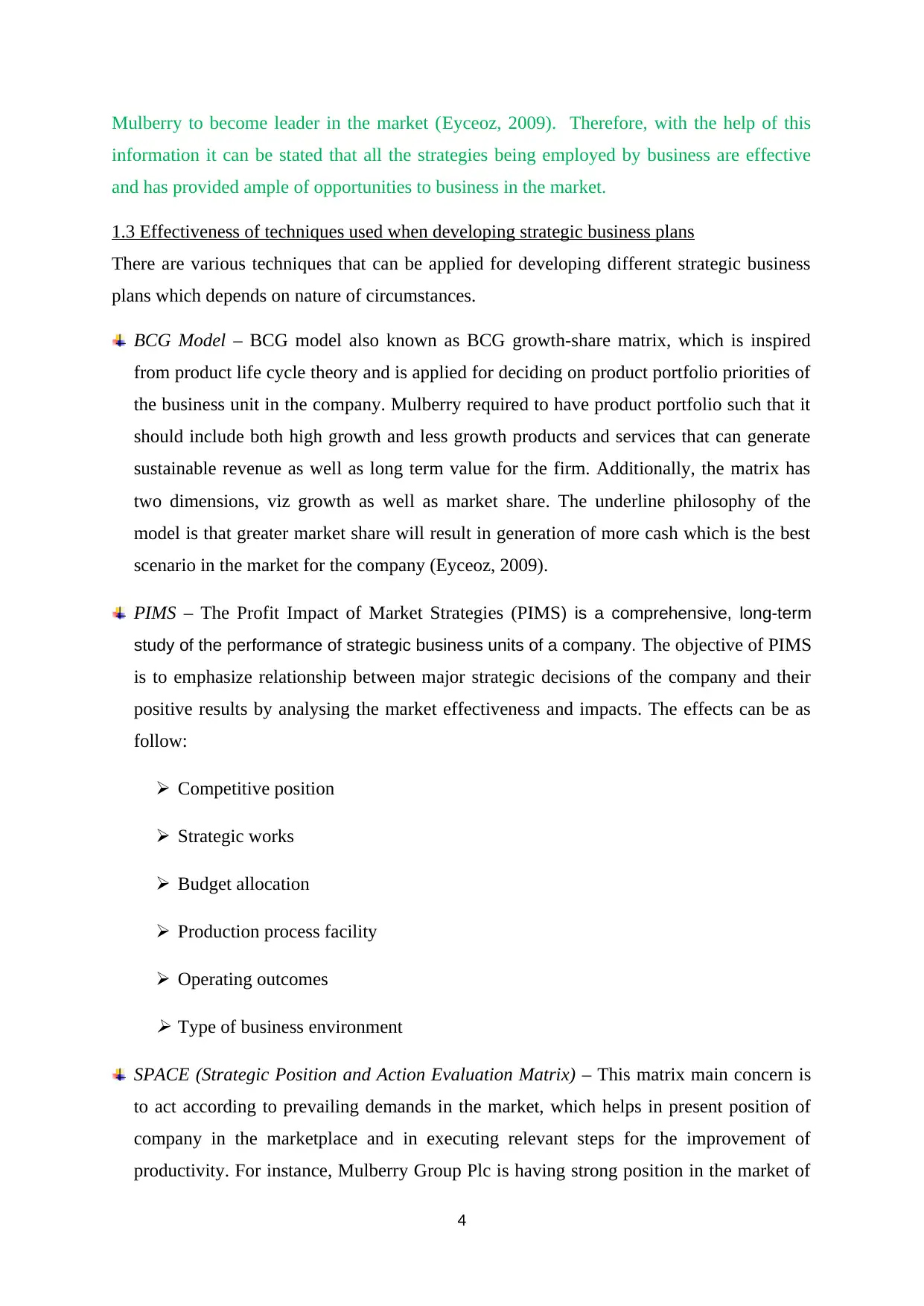
Mulberry to become leader in the market (Eyceoz, 2009). Therefore, with the help of this
information it can be stated that all the strategies being employed by business are effective
and has provided ample of opportunities to business in the market.
1.3 Effectiveness of techniques used when developing strategic business plans
There are various techniques that can be applied for developing different strategic business
plans which depends on nature of circumstances.
BCG Model – BCG model also known as BCG growth-share matrix, which is inspired
from product life cycle theory and is applied for deciding on product portfolio priorities of
the business unit in the company. Mulberry required to have product portfolio such that it
should include both high growth and less growth products and services that can generate
sustainable revenue as well as long term value for the firm. Additionally, the matrix has
two dimensions, viz growth as well as market share. The underline philosophy of the
model is that greater market share will result in generation of more cash which is the best
scenario in the market for the company (Eyceoz, 2009).
PIMS – The Profit Impact of Market Strategies (PIMS) is a comprehensive, long-term
study of the performance of strategic business units of a company. The objective of PIMS
is to emphasize relationship between major strategic decisions of the company and their
positive results by analysing the market effectiveness and impacts. The effects can be as
follow:
Competitive position
Strategic works
Budget allocation
Production process facility
Operating outcomes Type of business environment
SPACE (Strategic Position and Action Evaluation Matrix) – This matrix main concern is
to act according to prevailing demands in the market, which helps in present position of
company in the marketplace and in executing relevant steps for the improvement of
productivity. For instance, Mulberry Group Plc is having strong position in the market of
4
information it can be stated that all the strategies being employed by business are effective
and has provided ample of opportunities to business in the market.
1.3 Effectiveness of techniques used when developing strategic business plans
There are various techniques that can be applied for developing different strategic business
plans which depends on nature of circumstances.
BCG Model – BCG model also known as BCG growth-share matrix, which is inspired
from product life cycle theory and is applied for deciding on product portfolio priorities of
the business unit in the company. Mulberry required to have product portfolio such that it
should include both high growth and less growth products and services that can generate
sustainable revenue as well as long term value for the firm. Additionally, the matrix has
two dimensions, viz growth as well as market share. The underline philosophy of the
model is that greater market share will result in generation of more cash which is the best
scenario in the market for the company (Eyceoz, 2009).
PIMS – The Profit Impact of Market Strategies (PIMS) is a comprehensive, long-term
study of the performance of strategic business units of a company. The objective of PIMS
is to emphasize relationship between major strategic decisions of the company and their
positive results by analysing the market effectiveness and impacts. The effects can be as
follow:
Competitive position
Strategic works
Budget allocation
Production process facility
Operating outcomes Type of business environment
SPACE (Strategic Position and Action Evaluation Matrix) – This matrix main concern is
to act according to prevailing demands in the market, which helps in present position of
company in the marketplace and in executing relevant steps for the improvement of
productivity. For instance, Mulberry Group Plc is having strong position in the market of
4
⊘ This is a preview!⊘
Do you want full access?
Subscribe today to unlock all pages.

Trusted by 1+ million students worldwide
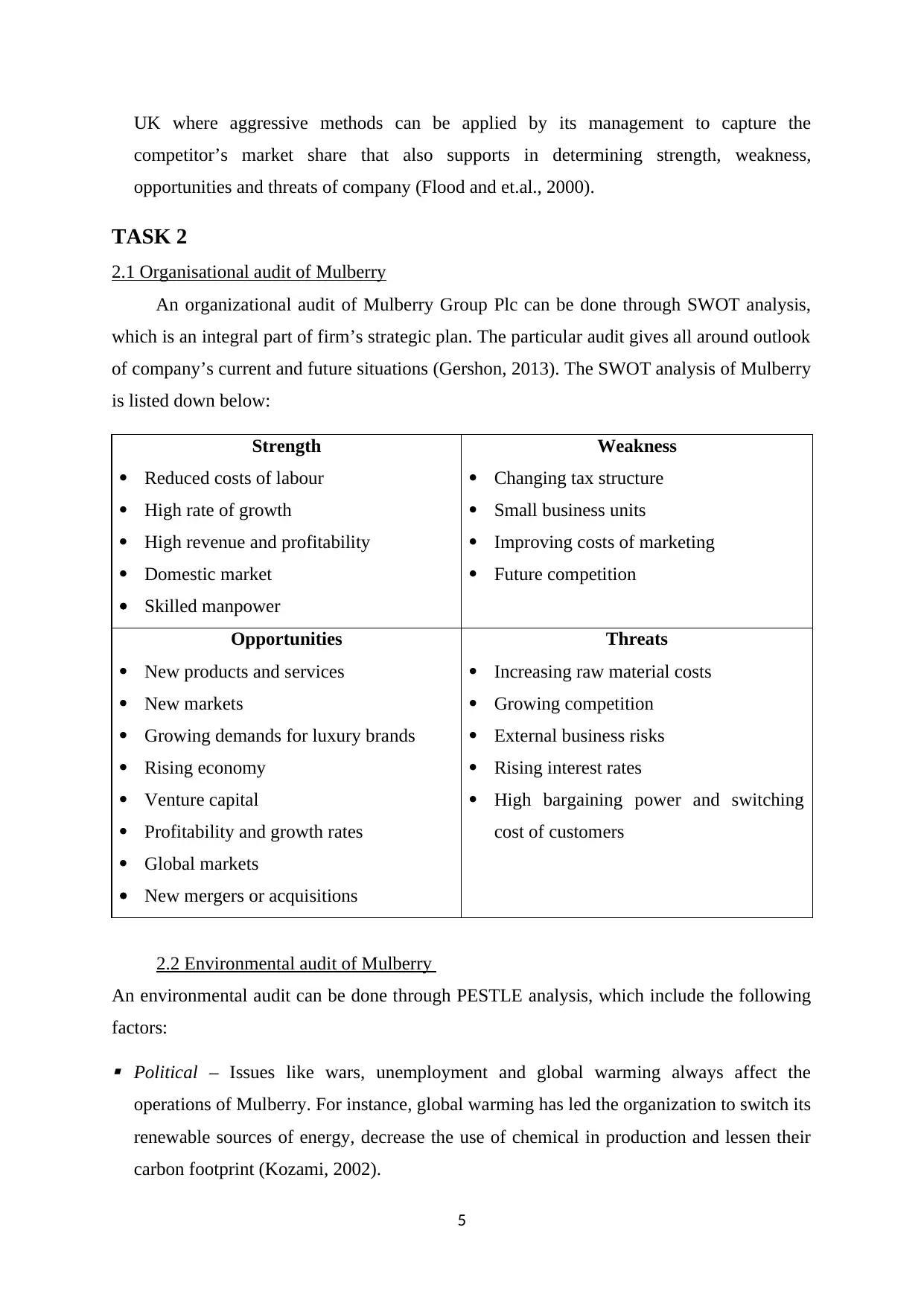
UK where aggressive methods can be applied by its management to capture the
competitor’s market share that also supports in determining strength, weakness,
opportunities and threats of company (Flood and et.al., 2000).
TASK 2
2.1 Organisational audit of Mulberry
An organizational audit of Mulberry Group Plc can be done through SWOT analysis,
which is an integral part of firm’s strategic plan. The particular audit gives all around outlook
of company’s current and future situations (Gershon, 2013). The SWOT analysis of Mulberry
is listed down below:
Strength
Reduced costs of labour
High rate of growth
High revenue and profitability
Domestic market
Skilled manpower
Weakness
Changing tax structure
Small business units
Improving costs of marketing
Future competition
Opportunities
New products and services
New markets
Growing demands for luxury brands
Rising economy
Venture capital
Profitability and growth rates
Global markets
New mergers or acquisitions
Threats
Increasing raw material costs
Growing competition
External business risks
Rising interest rates
High bargaining power and switching
cost of customers
2.2 Environmental audit of Mulberry
An environmental audit can be done through PESTLE analysis, which include the following
factors:
Political – Issues like wars, unemployment and global warming always affect the
operations of Mulberry. For instance, global warming has led the organization to switch its
renewable sources of energy, decrease the use of chemical in production and lessen their
carbon footprint (Kozami, 2002).
5
competitor’s market share that also supports in determining strength, weakness,
opportunities and threats of company (Flood and et.al., 2000).
TASK 2
2.1 Organisational audit of Mulberry
An organizational audit of Mulberry Group Plc can be done through SWOT analysis,
which is an integral part of firm’s strategic plan. The particular audit gives all around outlook
of company’s current and future situations (Gershon, 2013). The SWOT analysis of Mulberry
is listed down below:
Strength
Reduced costs of labour
High rate of growth
High revenue and profitability
Domestic market
Skilled manpower
Weakness
Changing tax structure
Small business units
Improving costs of marketing
Future competition
Opportunities
New products and services
New markets
Growing demands for luxury brands
Rising economy
Venture capital
Profitability and growth rates
Global markets
New mergers or acquisitions
Threats
Increasing raw material costs
Growing competition
External business risks
Rising interest rates
High bargaining power and switching
cost of customers
2.2 Environmental audit of Mulberry
An environmental audit can be done through PESTLE analysis, which include the following
factors:
Political – Issues like wars, unemployment and global warming always affect the
operations of Mulberry. For instance, global warming has led the organization to switch its
renewable sources of energy, decrease the use of chemical in production and lessen their
carbon footprint (Kozami, 2002).
5
Paraphrase This Document
Need a fresh take? Get an instant paraphrase of this document with our AI Paraphraser
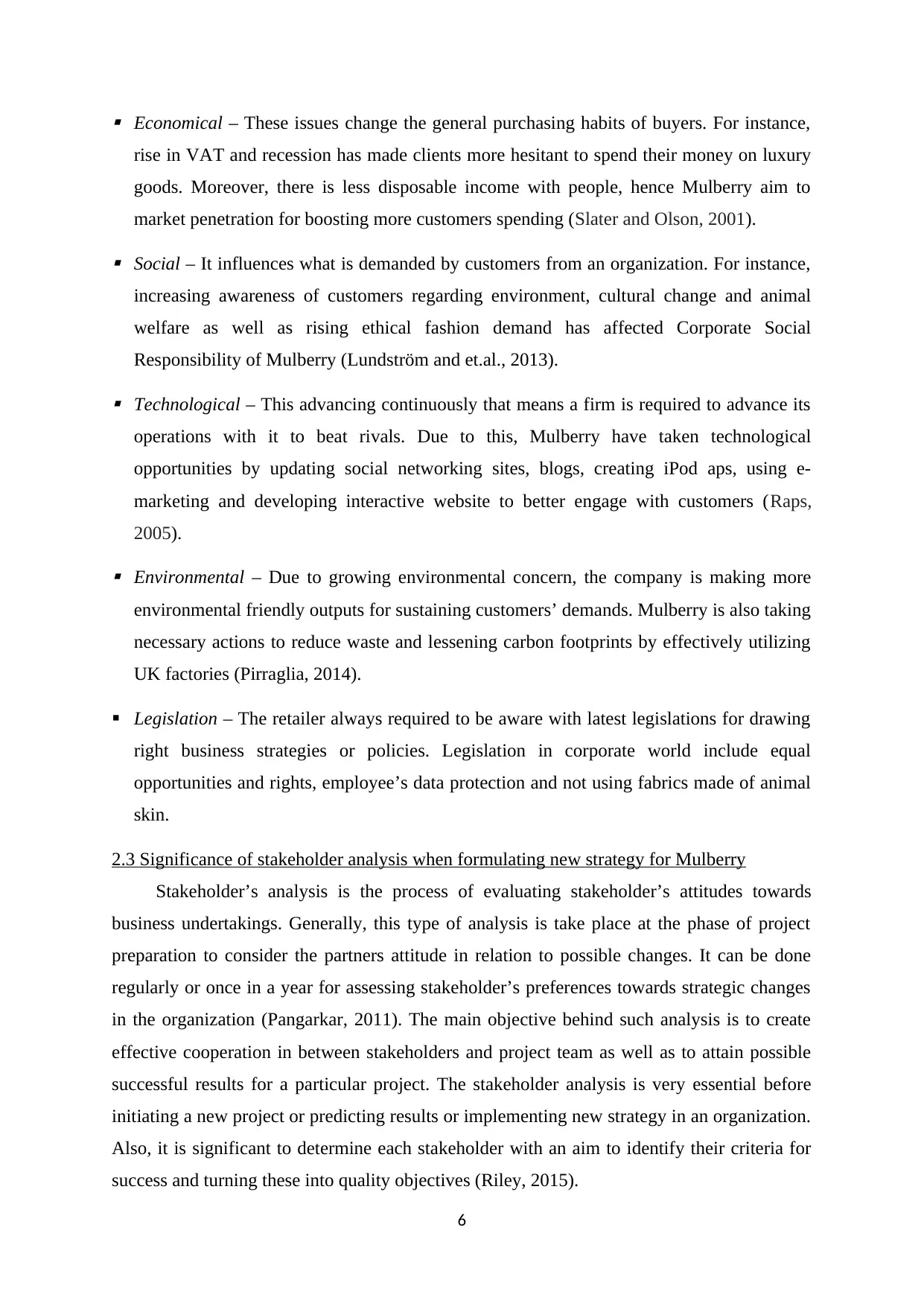
Economical – These issues change the general purchasing habits of buyers. For instance,
rise in VAT and recession has made clients more hesitant to spend their money on luxury
goods. Moreover, there is less disposable income with people, hence Mulberry aim to
market penetration for boosting more customers spending (Slater and Olson, 2001).
Social – It influences what is demanded by customers from an organization. For instance,
increasing awareness of customers regarding environment, cultural change and animal
welfare as well as rising ethical fashion demand has affected Corporate Social
Responsibility of Mulberry (Lundström and et.al., 2013).
Technological – This advancing continuously that means a firm is required to advance its
operations with it to beat rivals. Due to this, Mulberry have taken technological
opportunities by updating social networking sites, blogs, creating iPod aps, using e-
marketing and developing interactive website to better engage with customers (Raps,
2005).
Environmental – Due to growing environmental concern, the company is making more
environmental friendly outputs for sustaining customers’ demands. Mulberry is also taking
necessary actions to reduce waste and lessening carbon footprints by effectively utilizing
UK factories (Pirraglia, 2014).
Legislation – The retailer always required to be aware with latest legislations for drawing
right business strategies or policies. Legislation in corporate world include equal
opportunities and rights, employee’s data protection and not using fabrics made of animal
skin.
2.3 Significance of stakeholder analysis when formulating new strategy for Mulberry
Stakeholder’s analysis is the process of evaluating stakeholder’s attitudes towards
business undertakings. Generally, this type of analysis is take place at the phase of project
preparation to consider the partners attitude in relation to possible changes. It can be done
regularly or once in a year for assessing stakeholder’s preferences towards strategic changes
in the organization (Pangarkar, 2011). The main objective behind such analysis is to create
effective cooperation in between stakeholders and project team as well as to attain possible
successful results for a particular project. The stakeholder analysis is very essential before
initiating a new project or predicting results or implementing new strategy in an organization.
Also, it is significant to determine each stakeholder with an aim to identify their criteria for
success and turning these into quality objectives (Riley, 2015).
6
rise in VAT and recession has made clients more hesitant to spend their money on luxury
goods. Moreover, there is less disposable income with people, hence Mulberry aim to
market penetration for boosting more customers spending (Slater and Olson, 2001).
Social – It influences what is demanded by customers from an organization. For instance,
increasing awareness of customers regarding environment, cultural change and animal
welfare as well as rising ethical fashion demand has affected Corporate Social
Responsibility of Mulberry (Lundström and et.al., 2013).
Technological – This advancing continuously that means a firm is required to advance its
operations with it to beat rivals. Due to this, Mulberry have taken technological
opportunities by updating social networking sites, blogs, creating iPod aps, using e-
marketing and developing interactive website to better engage with customers (Raps,
2005).
Environmental – Due to growing environmental concern, the company is making more
environmental friendly outputs for sustaining customers’ demands. Mulberry is also taking
necessary actions to reduce waste and lessening carbon footprints by effectively utilizing
UK factories (Pirraglia, 2014).
Legislation – The retailer always required to be aware with latest legislations for drawing
right business strategies or policies. Legislation in corporate world include equal
opportunities and rights, employee’s data protection and not using fabrics made of animal
skin.
2.3 Significance of stakeholder analysis when formulating new strategy for Mulberry
Stakeholder’s analysis is the process of evaluating stakeholder’s attitudes towards
business undertakings. Generally, this type of analysis is take place at the phase of project
preparation to consider the partners attitude in relation to possible changes. It can be done
regularly or once in a year for assessing stakeholder’s preferences towards strategic changes
in the organization (Pangarkar, 2011). The main objective behind such analysis is to create
effective cooperation in between stakeholders and project team as well as to attain possible
successful results for a particular project. The stakeholder analysis is very essential before
initiating a new project or predicting results or implementing new strategy in an organization.
Also, it is significant to determine each stakeholder with an aim to identify their criteria for
success and turning these into quality objectives (Riley, 2015).
6
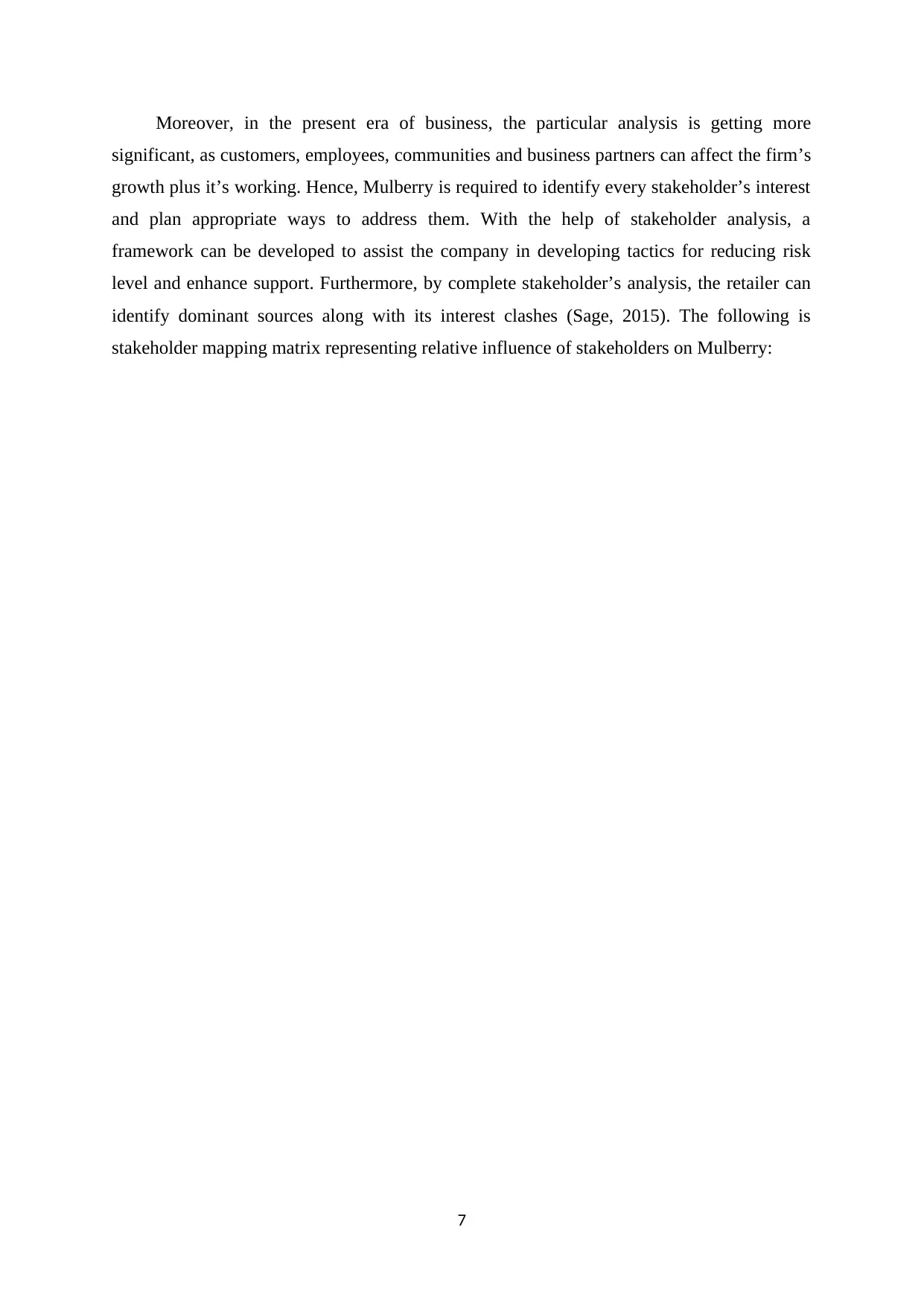
Moreover, in the present era of business, the particular analysis is getting more
significant, as customers, employees, communities and business partners can affect the firm’s
growth plus it’s working. Hence, Mulberry is required to identify every stakeholder’s interest
and plan appropriate ways to address them. With the help of stakeholder analysis, a
framework can be developed to assist the company in developing tactics for reducing risk
level and enhance support. Furthermore, by complete stakeholder’s analysis, the retailer can
identify dominant sources along with its interest clashes (Sage, 2015). The following is
stakeholder mapping matrix representing relative influence of stakeholders on Mulberry:
7
significant, as customers, employees, communities and business partners can affect the firm’s
growth plus it’s working. Hence, Mulberry is required to identify every stakeholder’s interest
and plan appropriate ways to address them. With the help of stakeholder analysis, a
framework can be developed to assist the company in developing tactics for reducing risk
level and enhance support. Furthermore, by complete stakeholder’s analysis, the retailer can
identify dominant sources along with its interest clashes (Sage, 2015). The following is
stakeholder mapping matrix representing relative influence of stakeholders on Mulberry:
7
⊘ This is a preview!⊘
Do you want full access?
Subscribe today to unlock all pages.

Trusted by 1+ million students worldwide
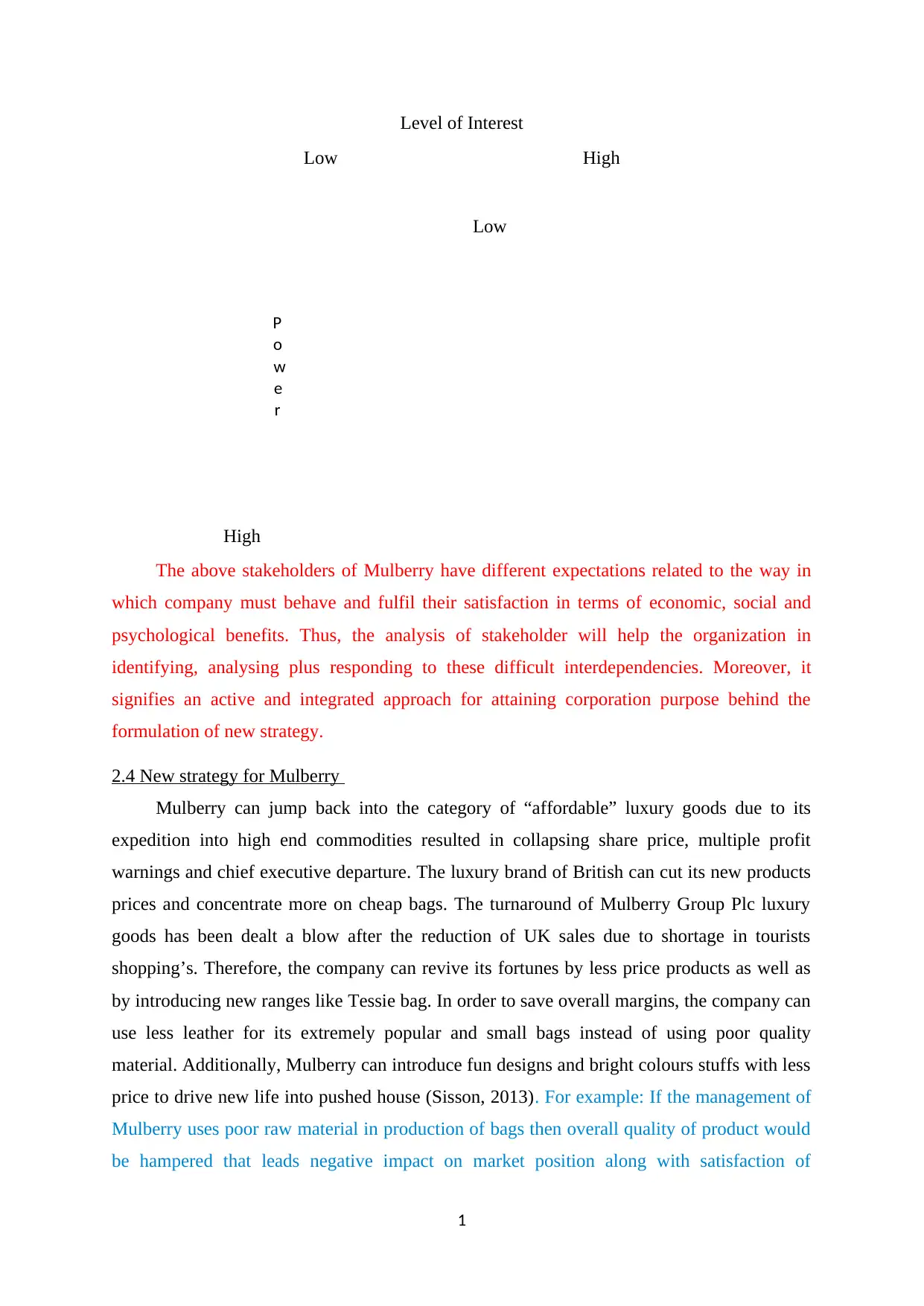
Level of Interest
Low High
Low
High
The above stakeholders of Mulberry have different expectations related to the way in
which company must behave and fulfil their satisfaction in terms of economic, social and
psychological benefits. Thus, the analysis of stakeholder will help the organization in
identifying, analysing plus responding to these difficult interdependencies. Moreover, it
signifies an active and integrated approach for attaining corporation purpose behind the
formulation of new strategy.
2.4 New strategy for Mulberry
Mulberry can jump back into the category of “affordable” luxury goods due to its
expedition into high end commodities resulted in collapsing share price, multiple profit
warnings and chief executive departure. The luxury brand of British can cut its new products
prices and concentrate more on cheap bags. The turnaround of Mulberry Group Plc luxury
goods has been dealt a blow after the reduction of UK sales due to shortage in tourists
shopping’s. Therefore, the company can revive its fortunes by less price products as well as
by introducing new ranges like Tessie bag. In order to save overall margins, the company can
use less leather for its extremely popular and small bags instead of using poor quality
material. Additionally, Mulberry can introduce fun designs and bright colours stuffs with less
price to drive new life into pushed house (Sisson, 2013). For example: If the management of
Mulberry uses poor raw material in production of bags then overall quality of product would
be hampered that leads negative impact on market position along with satisfaction of
1
P
o
w
e
r
Low High
Low
High
The above stakeholders of Mulberry have different expectations related to the way in
which company must behave and fulfil their satisfaction in terms of economic, social and
psychological benefits. Thus, the analysis of stakeholder will help the organization in
identifying, analysing plus responding to these difficult interdependencies. Moreover, it
signifies an active and integrated approach for attaining corporation purpose behind the
formulation of new strategy.
2.4 New strategy for Mulberry
Mulberry can jump back into the category of “affordable” luxury goods due to its
expedition into high end commodities resulted in collapsing share price, multiple profit
warnings and chief executive departure. The luxury brand of British can cut its new products
prices and concentrate more on cheap bags. The turnaround of Mulberry Group Plc luxury
goods has been dealt a blow after the reduction of UK sales due to shortage in tourists
shopping’s. Therefore, the company can revive its fortunes by less price products as well as
by introducing new ranges like Tessie bag. In order to save overall margins, the company can
use less leather for its extremely popular and small bags instead of using poor quality
material. Additionally, Mulberry can introduce fun designs and bright colours stuffs with less
price to drive new life into pushed house (Sisson, 2013). For example: If the management of
Mulberry uses poor raw material in production of bags then overall quality of product would
be hampered that leads negative impact on market position along with satisfaction of
1
P
o
w
e
r
Paraphrase This Document
Need a fresh take? Get an instant paraphrase of this document with our AI Paraphraser
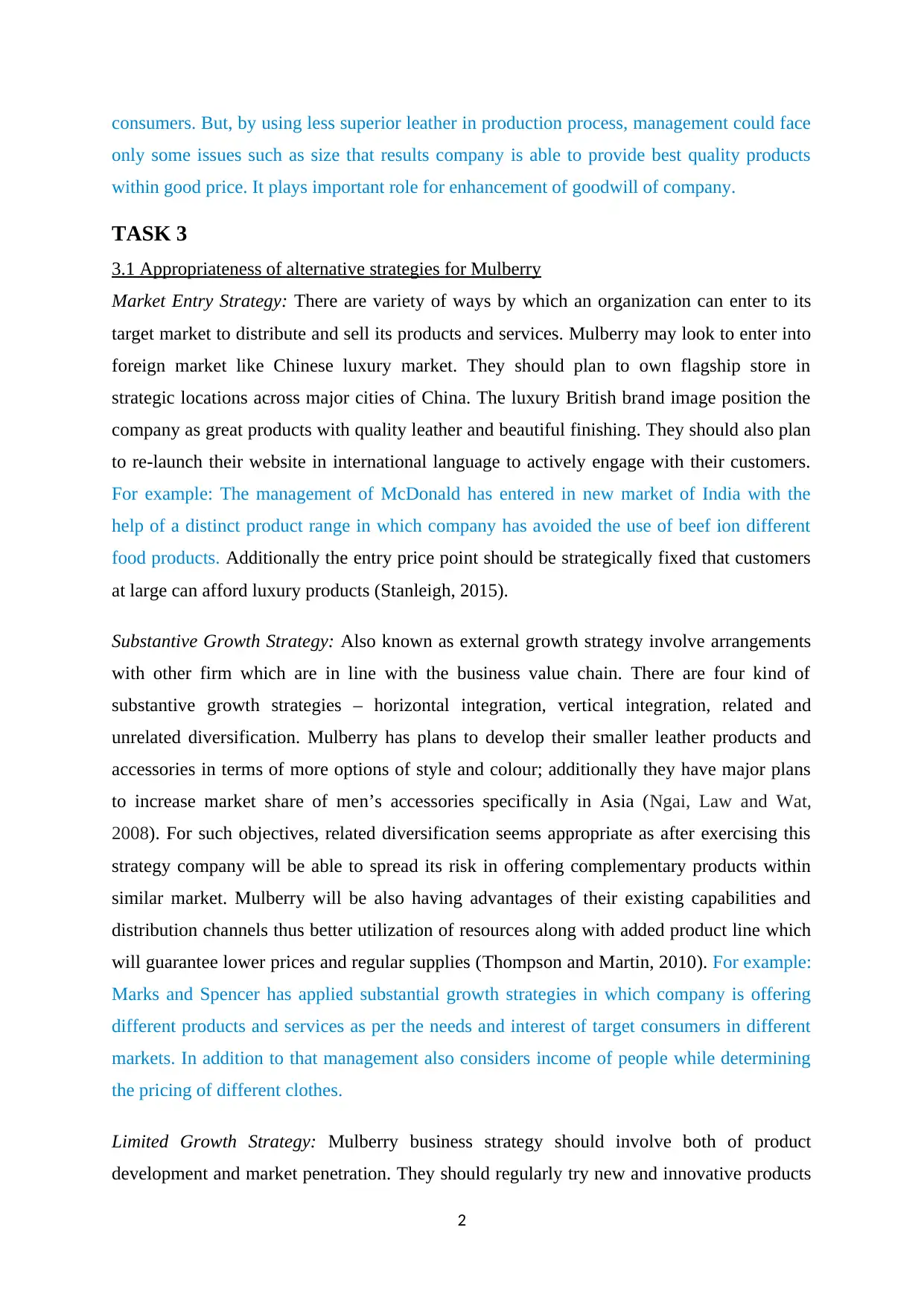
consumers. But, by using less superior leather in production process, management could face
only some issues such as size that results company is able to provide best quality products
within good price. It plays important role for enhancement of goodwill of company.
TASK 3
3.1 Appropriateness of alternative strategies for Mulberry
Market Entry Strategy: There are variety of ways by which an organization can enter to its
target market to distribute and sell its products and services. Mulberry may look to enter into
foreign market like Chinese luxury market. They should plan to own flagship store in
strategic locations across major cities of China. The luxury British brand image position the
company as great products with quality leather and beautiful finishing. They should also plan
to re-launch their website in international language to actively engage with their customers.
For example: The management of McDonald has entered in new market of India with the
help of a distinct product range in which company has avoided the use of beef ion different
food products. Additionally the entry price point should be strategically fixed that customers
at large can afford luxury products (Stanleigh, 2015).
Substantive Growth Strategy: Also known as external growth strategy involve arrangements
with other firm which are in line with the business value chain. There are four kind of
substantive growth strategies – horizontal integration, vertical integration, related and
unrelated diversification. Mulberry has plans to develop their smaller leather products and
accessories in terms of more options of style and colour; additionally they have major plans
to increase market share of men’s accessories specifically in Asia (Ngai, Law and Wat,
2008). For such objectives, related diversification seems appropriate as after exercising this
strategy company will be able to spread its risk in offering complementary products within
similar market. Mulberry will be also having advantages of their existing capabilities and
distribution channels thus better utilization of resources along with added product line which
will guarantee lower prices and regular supplies (Thompson and Martin, 2010). For example:
Marks and Spencer has applied substantial growth strategies in which company is offering
different products and services as per the needs and interest of target consumers in different
markets. In addition to that management also considers income of people while determining
the pricing of different clothes.
Limited Growth Strategy: Mulberry business strategy should involve both of product
development and market penetration. They should regularly try new and innovative products
2
only some issues such as size that results company is able to provide best quality products
within good price. It plays important role for enhancement of goodwill of company.
TASK 3
3.1 Appropriateness of alternative strategies for Mulberry
Market Entry Strategy: There are variety of ways by which an organization can enter to its
target market to distribute and sell its products and services. Mulberry may look to enter into
foreign market like Chinese luxury market. They should plan to own flagship store in
strategic locations across major cities of China. The luxury British brand image position the
company as great products with quality leather and beautiful finishing. They should also plan
to re-launch their website in international language to actively engage with their customers.
For example: The management of McDonald has entered in new market of India with the
help of a distinct product range in which company has avoided the use of beef ion different
food products. Additionally the entry price point should be strategically fixed that customers
at large can afford luxury products (Stanleigh, 2015).
Substantive Growth Strategy: Also known as external growth strategy involve arrangements
with other firm which are in line with the business value chain. There are four kind of
substantive growth strategies – horizontal integration, vertical integration, related and
unrelated diversification. Mulberry has plans to develop their smaller leather products and
accessories in terms of more options of style and colour; additionally they have major plans
to increase market share of men’s accessories specifically in Asia (Ngai, Law and Wat,
2008). For such objectives, related diversification seems appropriate as after exercising this
strategy company will be able to spread its risk in offering complementary products within
similar market. Mulberry will be also having advantages of their existing capabilities and
distribution channels thus better utilization of resources along with added product line which
will guarantee lower prices and regular supplies (Thompson and Martin, 2010). For example:
Marks and Spencer has applied substantial growth strategies in which company is offering
different products and services as per the needs and interest of target consumers in different
markets. In addition to that management also considers income of people while determining
the pricing of different clothes.
Limited Growth Strategy: Mulberry business strategy should involve both of product
development and market penetration. They should regularly try new and innovative products
2
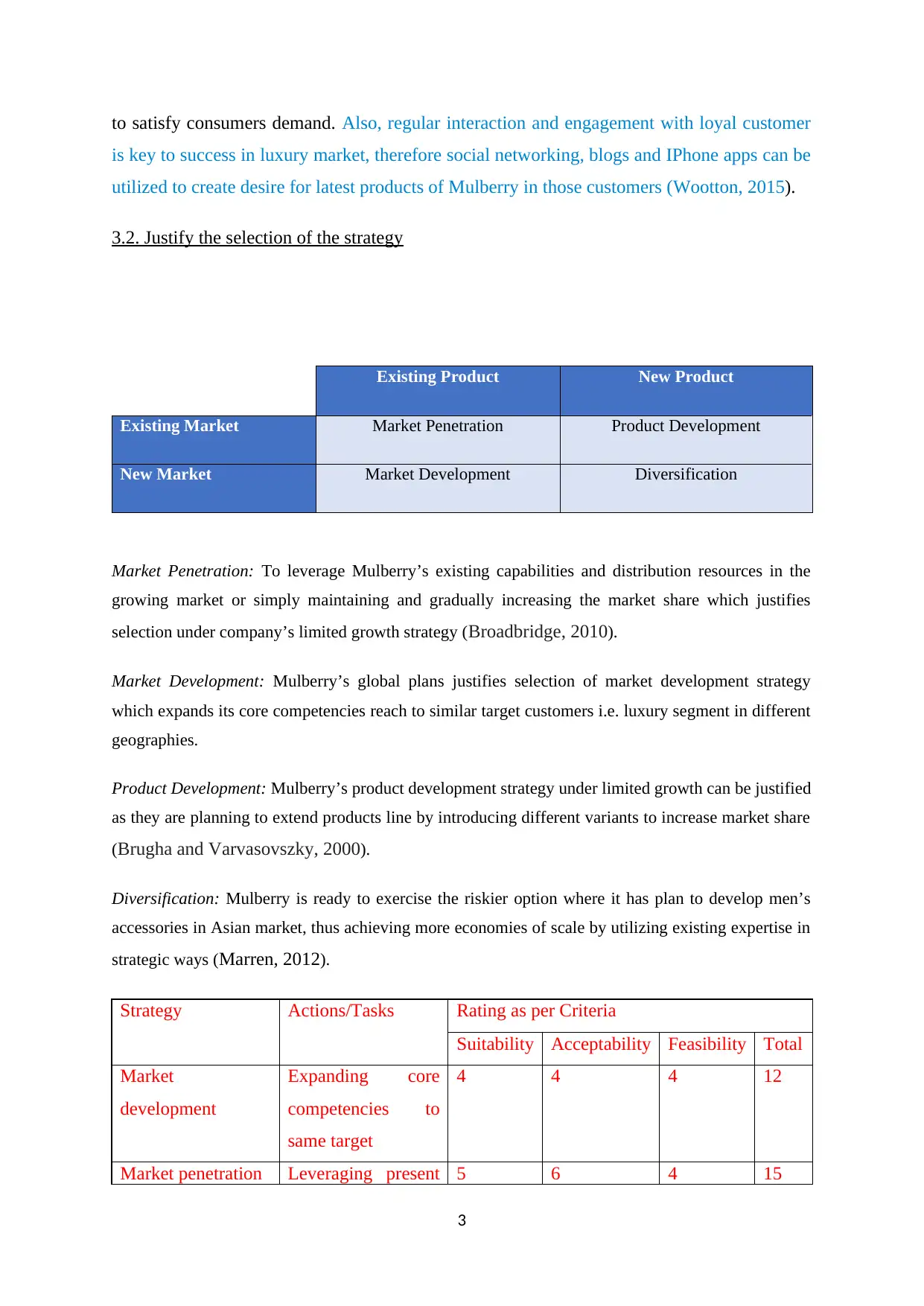
to satisfy consumers demand. Also, regular interaction and engagement with loyal customer
is key to success in luxury market, therefore social networking, blogs and IPhone apps can be
utilized to create desire for latest products of Mulberry in those customers (Wootton, 2015).
3.2. Justify the selection of the strategy
The Ansoff’s matrix can be utilized to justifiably select alternative corporate growth strategy.
There are four product and market combinations that the firm should consider whether to grow
by new products or existing products, and in existing markets or new markets.
Existing Product New Product
Existing Market Market Penetration Product Development
New Market Market Development Diversification
Market Penetration: To leverage Mulberry’s existing capabilities and distribution resources in the
growing market or simply maintaining and gradually increasing the market share which justifies
selection under company’s limited growth strategy (Broadbridge, 2010).
Market Development: Mulberry’s global plans justifies selection of market development strategy
which expands its core competencies reach to similar target customers i.e. luxury segment in different
geographies.
Product Development: Mulberry’s product development strategy under limited growth can be justified
as they are planning to extend products line by introducing different variants to increase market share
(Brugha and Varvasovszky, 2000).
Diversification: Mulberry is ready to exercise the riskier option where it has plan to develop men’s
accessories in Asian market, thus achieving more economies of scale by utilizing existing expertise in
strategic ways (Marren, 2012).
Strategy Actions/Tasks Rating as per Criteria
Suitability Acceptability Feasibility Total
Market
development
Expanding core
competencies to
same target
4 4 4 12
Market penetration Leveraging present 5 6 4 15
3
is key to success in luxury market, therefore social networking, blogs and IPhone apps can be
utilized to create desire for latest products of Mulberry in those customers (Wootton, 2015).
3.2. Justify the selection of the strategy
The Ansoff’s matrix can be utilized to justifiably select alternative corporate growth strategy.
There are four product and market combinations that the firm should consider whether to grow
by new products or existing products, and in existing markets or new markets.
Existing Product New Product
Existing Market Market Penetration Product Development
New Market Market Development Diversification
Market Penetration: To leverage Mulberry’s existing capabilities and distribution resources in the
growing market or simply maintaining and gradually increasing the market share which justifies
selection under company’s limited growth strategy (Broadbridge, 2010).
Market Development: Mulberry’s global plans justifies selection of market development strategy
which expands its core competencies reach to similar target customers i.e. luxury segment in different
geographies.
Product Development: Mulberry’s product development strategy under limited growth can be justified
as they are planning to extend products line by introducing different variants to increase market share
(Brugha and Varvasovszky, 2000).
Diversification: Mulberry is ready to exercise the riskier option where it has plan to develop men’s
accessories in Asian market, thus achieving more economies of scale by utilizing existing expertise in
strategic ways (Marren, 2012).
Strategy Actions/Tasks Rating as per Criteria
Suitability Acceptability Feasibility Total
Market
development
Expanding core
competencies to
same target
4 4 4 12
Market penetration Leveraging present 5 6 4 15
3
⊘ This is a preview!⊘
Do you want full access?
Subscribe today to unlock all pages.

Trusted by 1+ million students worldwide
1 out of 19
Related Documents
Your All-in-One AI-Powered Toolkit for Academic Success.
+13062052269
info@desklib.com
Available 24*7 on WhatsApp / Email
![[object Object]](/_next/static/media/star-bottom.7253800d.svg)
Unlock your academic potential
Copyright © 2020–2025 A2Z Services. All Rights Reserved. Developed and managed by ZUCOL.





